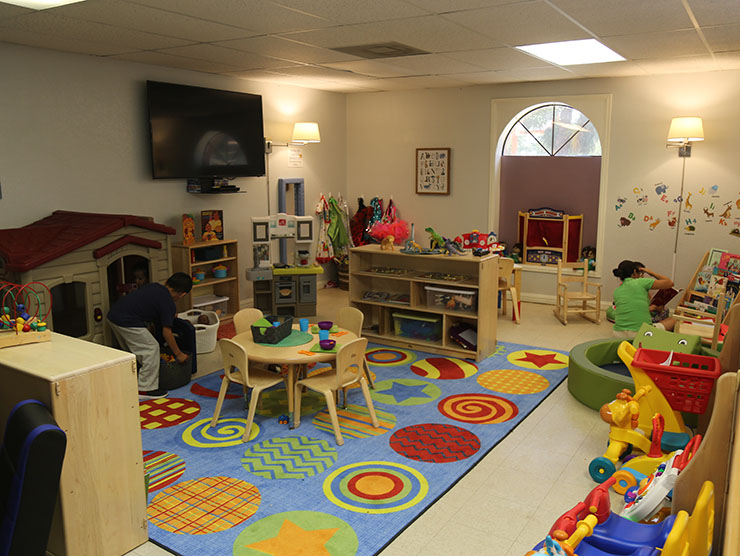CEO Stephen Kramer Discusses McAllen Bright Space in Exchange Magazine

September 17, 2018 – The Humanitarian Respite Center Restoring Dignity Bright Space in McAllen, Texas was featured as the cover story of the September/October issue of Exchange Magazine. The issue includes the below interview with CEO Stephen Kramer about how important this was to Bright Horizons to support the children and families in need, as well as a feature article written by Bright Horizons Foundation for Children National Director of Bright Spaces Ileen Henderson, which details the journey creating the Bright Space.
An Interview with Stephen Kramer, CEO of Bright Horizons
By Sara Gilliam
When we saw those images from the Southern U.S. border, many of us felt helpless. How did you propel from sadness into action?
I, too, felt an incredible amount of sadness. While I work in this field and am incredibly passionate about young children, it felt overwhelming to contemplate how I, or this organization, could support the families in need. I drew strength from the fact that Bright Horizons has a culture in which we always come together and figure out how we can add value to difficult situations. We can very quickly move from a place of sadness and feeling overwhelmed to action. I also drew an incredible amount of strength from the overtures of our employees, many of whom were saying, “I want to help.”
What guided your initial motivation to travel to McAllen?
You won’t be surprised to know that I have very strong convictions around the culture that exists at Bright Horizons. The lines between how I feel personally and how the organization feels are inextricably linked, not because I say it’s so, but rather because I am one of the 31,000 people who are passionate not only about the work we do but who we are as an organization.
The reason I knew we needed to get involved—and the reason others within the organization needed to get involved—was that we felt strongly about the situation, and we also knew we had unique expertise that could help the families at the border. We respond to those tragedies for which we feel we have a unique value or perspective to lend. When we saw the photographs and images that everyone else saw, we knew we had the ability to mobilize and have an immediate impact.
Was it important to you to take a strong moral stance and communicate it to everyone within Bright Horizons?
My leadership style is very personal. I spend a lot of time visiting centers, interacting and speaking and learning from our teachers, and I feel like the beneficiary of a personal relationship with a large number of people within our organization. At the same time, I feel it’s important that people who are with Bright Horizons really understand my character, and understand what is important to their CEO. It was important to me to share with them how I was authentically feeling about this situation, and know that I was mirroring the feelings of many of the people who work at Bright Horizons.
Over time, it became this incredible feedback loop; I would send out an email with my thoughts, perspectives and feelings, and I would get an incredible number of emails back from staff sharing their personal stories … how they came to this company as immigrants or have staff who are personally impacted by this crisis. It showed me how deep and meaningful this issue was to them. I received hundreds of emails and I personally responded to each and every one of them, because to me it’s really important not just to share, but also to listen and respond, and demonstrate that peoples’ stories are meaningful and really do have an impact.
In a situation like this, what is the role of our early childhood community?
First of all, I think as people, we have an obligation to respond to situations like the one at the border. As early childhood practitioners committed to the safety and caring and well-being of children, we hold an even greater responsibility, because we have the skills and the knowledge to have an impact in ways that people in other fields do not.
When I think of the 11 Bright Horizons employees who went to McAllen—and the hundreds of people supporting them behind the scenes—they did an incredible thing that will have lasting impacts on families. That is our obligation. There is so much more outside of what we do every day. There are opportunities like this, where we can step in and contribute even more than we already do every day for the lives of young children.
What was your most powerful takeaway from your visit to McAllen?
I was on the exploratory visit, to figure out where we could offer support. The most vivid images were those of children coming into the respite center, where there was not yet an appropriate place for them to find refuge; there was not a place with developmentally appropriate toys or books, or things that would let them be a child, just for a moment. That was the image that was emblazoned in my mind, in terms of what we needed to do to support the families coming in: the powerful image of the “before.” This was another obstacle in their path and journey, and that was what ultimately gave me the strength to make sure that our Bright Horizons team mobilized quickly. My visit propelled me to feel the urgency, and the need, to make sure that we were able to respond in a way that was expeditious and meaningful.
You can read the entire article in the September/October issue of Exchange Magazine (the article starts on page 28), or online by clicking here.
Copyright © Dimensions Educational Research Foundation. Reprinted with permission from Exchange Press. All rights reserved. Visit: www.ChildCareExchange.com or call (800) 221-2864.
